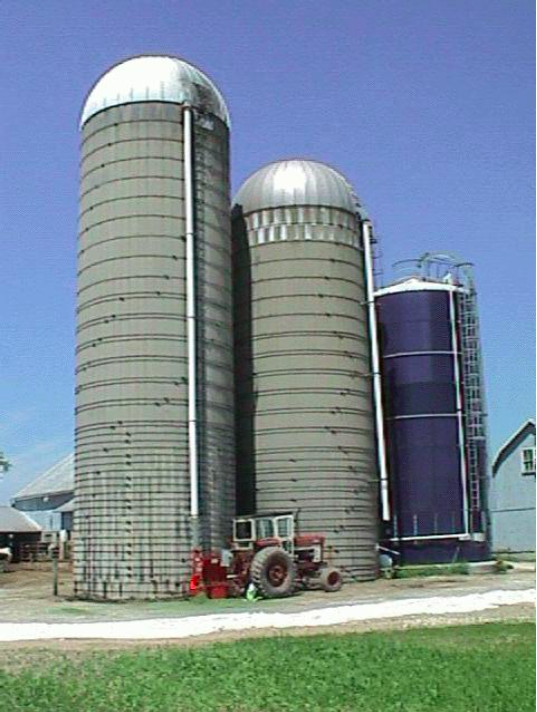Making a Feed Inventory
by Brian Holmes
What is a feed inventory?
Doing a feed inventory establishes your current stock of various feed ingredients. Generally, the process involves determining the volume of each feed stored and then multiplying by the stored density to yield a weight of feed.
For example, silage in a bunker silo has a dimension of 30’ x 10’ x 50’. Its volume is 15,000 cu ft. If the silage has a stored density of 40 lb (as fed) /cu ft, the weight of feed in the bunker is:
15,000 cu ft x 40 lb AF /cu ft = 600,000 lb = 300 T as fed.
There are several ways to do a feed inventory: 1) pencil and paper, 2) computer spreadsheets, 3) commercial software that integrates with your feed weighing system. There are a number of publications and software tools that can help establish your feed inventory. Some of these materials are listed below:
Dairy Freestall Housing and Equipment (MWPS-7). Tables of quantities of feeds in various storage types. Call 1-800-562-3618 or https://www-mwps.sws.iastate.edu/catalog/livestock/dairy/dairy-freestall-housing-and-equipment to order.
Other MWPS publications have feed storage information as follows:
MWPS-Grain/Forage/Silage Publications
https://www-mwps.sws.iastate.edu/catalog/grain-handling-storage
MWPS Dairy Publications
https://www-mwps.sws.iastate.edu/catalog/livestock-operations/dairy
MWPS Beef Publications
https://www-mwps.sws.iastate.edu/catalog/livestock-operations/beef
The following materials can be found at the University of Wisconsin Extension Team Forage Harvesting and Storage webpage: https://fyi.extension.wisc.edu/forage/harvest/
Spreadsheets
Silage Pile Capacity Calculator
Silage Pile Density Calculator
Bunker Silo Volume and Weight Calculator
Bunker Silo Density Calculator
Bunker Silo Sizing Spreadsheet – includes a section for estimating density based on weight removed divided by volume removed
Silage Bag Capacity Calculator
Storage Density Calculator – allows a person to calculate density based on weight removed divided by volume removed
Tower Silo Capacity Calculator
Tower Silo Capacity Calculator–Multiple Fills
Cost of Forage Storage Spreadsheet – look in the help section for calculators for storage areas for bags, piles, bunkers, silage bales, etc.
Grain Bin Capacity Calculator
Estimating Winter Hay Needs for Beef Cattle
Publications
Silage Bag Capacity
Choosing Forage Storage Facilities
Density and Losses in Pressed Bag Silos
The Crop Storage Institute has a Spreadsheet for Determining Capacity of Various Storages: http://www.cropstorage.com/silocap.xls
What is inventory management?
Feed inventory management is slightly more complicated. With inventory management, you are predicting how long an ingredient will be available to feed and making adjustments accordingly. If the projected date to feed depletion occurs before a new crop comes in, you need to consider if you will reduce the rate of consumption to extend the feed ingredient, purchase more of that feed, substitute an existing feed ingredient into the ration or a combination of these choices.
How long will my feed last?
The projected Time to Inventory Depletion = Feed Inventory (tons) / Consumption Rate (tons/day)
For example:
100 tons stored/ 2 tons fed/day = 50 days to depletion
Will feed need to be purchased?
The projected Feed to Purchase (tons as fed) to meet feed needs at a given consumption rate is:
Feed Inventory (tons) – [Consumption Rate (tons/day) × Time till harvest (days)]
For example:
100 tons – [2 tons/day × 70 days] = −40 tons (as fed) to purchase
(negative value means feed to purchase, positive value means excess feed)
There are a number of publications and software tools that can help establish your inventory and manage it. Some of these materials are listed below:
Managing Dairy Feed Inventory (A2945) – a University of Wisconsin bulletin available through your county extension office or off the internet at: http://learningstore.extension.wisc.edu/assets/pdfs/a2945.pdf
NOTE: there is an error in this publication. Area of a circle should be Pi x D2/4
Dairy Feed Inventory Planner – a useful dairy inventory spreadsheet developed by a Michigan State University extension area dairy agent. Download at: https://www.msu.edu/user/steind/FEEDINV.XLS Instructions for the above spreadsheet are at: https://www.msu.edu/~steind/FEEDINV_INSTRUCTIONS.pdf
The Penn State Cash Flow Analyzer incorporates a feed inventory component to the spreadsheet. http://extension.psu.edu/animals/dairy/business-management/financial-tools/cash-flow-planning
Checklist for the Top 5 Priorities for Fall/Winter Dairy Feeding Programs (extension article) http://www.extension.org/pages/65108/checklist-for-the- top-5-priorities-for-fallwinter-dairy-feeding-programs
An article on Calculating Bushels is found in the “Handouts” section at: http://bbe.umn.edu/postharvest
When is the best time to do a feed inventory?
There is no one best time to do an inventory. Doing an inventory at different times for different reasons may be beneficial. For example, doing an inventory in:
October/November – allows you to make a projection to see if purchased feed will be needed or if the consumption rate needs to be adjusted. This allows needed purchases when commodity prices are apt to be lower in winter and will allow purchases before December 31, assisting in tax management.
February/March – allows you to make a mid-course correction prior to the harvest season. Estimates of density will be more accurate after having fed from a storage for a while, so estimates of quantity stored will be more accurate.
June/July – allows you an early warning of inadequacy of feed supplies for the up-coming feeding season. Purchases of standing crops remain an option if deficiencies are discovered.
Anytime you are required by a lender to provide a balance sheet, a feed inventory and the feed value is needed.
Where can I get help with inventory management?
The information available from the sources in this article will be of help in doing your inventory and its management. Don’t overlook the assistance available from UW Extension county agents and well-trained nutrition professionals who can help you with these issues and decisions.
![]() Focus on Forage – Vol 5: No. 1
Focus on Forage – Vol 5: No. 1
© University of Wisconsin Board of Regents, 2012
Brian Holmes, Extension Ag Engineer
University of Wisconsin-Madison
bjholmes@wisc.edu





